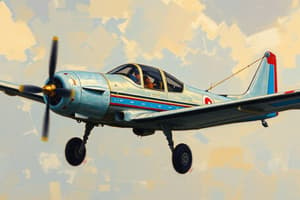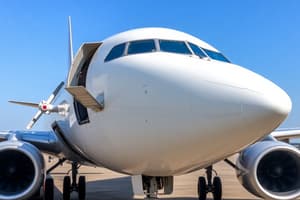Podcast
Questions and Answers
Why are safety instruction cards placed in every seat pocket?
Why are safety instruction cards placed in every seat pocket?
- To provide entertainment during the flight.
- To help passengers locate emergency exits and operate safety equipment/life jackets. (correct)
- To advertise other destinations the airline flies to.
- To give passengers something to read while waiting for takeoff.
Taxiways are specifically established for aircraft to take off from.
Taxiways are specifically established for aircraft to take off from.
False (B)
What is the term for the time an aircraft spends on the ground for unloading and loading of customers, crew, catering, and fuel?
What is the term for the time an aircraft spends on the ground for unloading and loading of customers, crew, catering, and fuel?
Turnaround
The concrete or bitumen area in front of hangars and buildings where aircraft loading and unloading is carried out is known as the _______ or Apron.
The concrete or bitumen area in front of hangars and buildings where aircraft loading and unloading is carried out is known as the _______ or Apron.
Match the terms with their correct descriptions:
Match the terms with their correct descriptions:
Which of the following is NOT a responsibility held by the Captain of an aircraft?
Which of the following is NOT a responsibility held by the Captain of an aircraft?
A First Officer can be identified by three silver bars on their shoulder epaulettes.
A First Officer can be identified by three silver bars on their shoulder epaulettes.
What Rolls Royce engine type powers the Fokker F70?
What Rolls Royce engine type powers the Fokker F70?
According to the phonetic alphabet, the letter 'E' is represented by the word ______.
According to the phonetic alphabet, the letter 'E' is represented by the word ______.
Match the following cities with their corresponding port designator codes:
Match the following cities with their corresponding port designator codes:
If Alliance Airlines changed its name, what airline designator code would it retain?
If Alliance Airlines changed its name, what airline designator code would it retain?
Which aircraft has the largest seating capacity?
Which aircraft has the largest seating capacity?
How many flight attendants are on the Fokker F100?
How many flight attendants are on the Fokker F100?
Which of the following accurately describes the function of an Aerobridge?
Which of the following accurately describes the function of an Aerobridge?
An alternate airport is selected only when there is a mechanical issue with the aircraft en route.
An alternate airport is selected only when there is a mechanical issue with the aircraft en route.
What is the primary function of the flashing red beacons fitted to an aircraft?
What is the primary function of the flashing red beacons fitted to an aircraft?
The senior member of the cabin crew who manages the Flight Attendants is called the ______.
The senior member of the cabin crew who manages the Flight Attendants is called the ______.
Match the aviation term with its corresponding description:
Match the aviation term with its corresponding description:
What is the main purpose of 'deadheading' in the context of airline operations?
What is the main purpose of 'deadheading' in the context of airline operations?
A 'ferry flight' always carries passengers but no cargo.
A 'ferry flight' always carries passengers but no cargo.
What does 'Fuselage' refer to in aviation terminology?
What does 'Fuselage' refer to in aviation terminology?
The aircraft's kitchen for storage and preparation of catering is called the ______.
The aircraft's kitchen for storage and preparation of catering is called the ______.
What is the role of a Ground Handling Agent (GHA)?
What is the role of a Ground Handling Agent (GHA)?
A Hangar is a type of aircraft fuel.
A Hangar is a type of aircraft fuel.
Which of the following describes a 'Holding' procedure?
Which of the following describes a 'Holding' procedure?
What unit of speed is equal to 6080 feet per hour?
What unit of speed is equal to 6080 feet per hour?
The maximum allowable weight of an aircraft at take-off for given conditions and structural limitations is known as ______.
The maximum allowable weight of an aircraft at take-off for given conditions and structural limitations is known as ______.
What is the purpose of a 'Safety Feature Demonstration'?
What is the purpose of a 'Safety Feature Demonstration'?
Flashcards
Embraer 190
Embraer 190
A regional jet powered by 2 turbofan engines with a seating capacity of 94-100.
Fokker F100
Fokker F100
A regional jet with 2 Rolls Royce engines, seating capacity of 100.
Fokker F70
Fokker F70
A smaller regional jet with 2 Rolls Royce engines; seating for 80 or 48 business class.
Captain
Captain
Signup and view all the flashcards
First Officer
First Officer
Signup and view all the flashcards
Phonetic Alphabet
Phonetic Alphabet
Signup and view all the flashcards
Port Designator Codes
Port Designator Codes
Signup and view all the flashcards
Airline Designator Codes
Airline Designator Codes
Signup and view all the flashcards
Safety Instructions Card
Safety Instructions Card
Signup and view all the flashcards
Taxiing
Taxiing
Signup and view all the flashcards
Turnaround
Turnaround
Signup and view all the flashcards
Undercarriage
Undercarriage
Signup and view all the flashcards
Tarmac
Tarmac
Signup and view all the flashcards
A/B Passenger
A/B Passenger
Signup and view all the flashcards
A/C
A/C
Signup and view all the flashcards
Aerobridge
Aerobridge
Signup and view all the flashcards
Alternate Airport
Alternate Airport
Signup and view all the flashcards
Altitude
Altitude
Signup and view all the flashcards
ATC
ATC
Signup and view all the flashcards
Cabin Crew
Cabin Crew
Signup and view all the flashcards
Chock
Chock
Signup and view all the flashcards
Cruise Level
Cruise Level
Signup and view all the flashcards
Deadheading
Deadheading
Signup and view all the flashcards
Disembark
Disembark
Signup and view all the flashcards
ETA
ETA
Signup and view all the flashcards
Flight Plan
Flight Plan
Signup and view all the flashcards
Galley
Galley
Signup and view all the flashcards
Pushback
Pushback
Signup and view all the flashcards
Study Notes
Aircraft Specifications
- Embraer 190: Powered by two high-bypass turbofan engines; seats 94-100 passengers; crew includes Captain, First Officer, Cabin Manager, and one or two Flight Attendants.
- Fokker F100: Powered by two Rolls Royce Tay Mk 650-15 engines; seats 100 passengers; crew includes Captain, First Officer, Cabin Manager, and one or two Flight Attendants.
- Fokker F70: Powered by two Rolls Royce Tay Mk 620-15 engines; seats 80 passengers or 48 in a business class configuration; crew includes Captain, First Officer, Cabin Manager, and one or two Flight Attendants.
Flight Crew Roles
- Captain (CAPT): Full command of the aircraft and crew; sits in the left-hand seat; identified by four gold bars on epaulettes.
- First Officer (F/O): Co-pilot and second in command; sits in the right-hand seat; identified by three gold bars on epaulettes.
Aviation Terminology & Abbreviations
- ABP: Able Bodied Passenger
- A/C: Aircraft
- Aerobridge: Covered retractable walkway from gate lounge to aircraft
- Alternate Airport: Airport for diversion if landing at destination is impossible
- Altitude: Vertical distance of aircraft, usually above sea level
- A/P: Airport
- Approach Lights: High intensity lights guiding pilots onto the runway
- APU: Auxiliary Power Unit
- ASIC: Aviation Security Identification Card
- ATC: Air Traffic Control
- Automatic Pilot: System for automatic flight
- Beacons: Flashing red lights on aircraft for safety warnings or engine status
- Briefing: Pre-flight instructions
- Bulkhead: Fixed aircraft interior structure, e.g., galley
- Cabin: Passenger seating area
- Cabin Crew: All Flight Attendants and Cabin Managers
- CAO: Civil Aviation Order
- Cabin Manager (CM): Senior Cabin Crew member managing Flight Attendants
- Carry-on Baggage: Personal items brought into the aircraft cabin
- CAR: Civil Aviation Regulation
- CASA: Civil Aviation Safety Authority
- Catering: Food, beverages, and equipment for flights
- Chock: Rubber or steel block placed against aircraft wheels
- COBT: Calculated Off Block Time
- Concourse: Walkway to gate lounges
- Control Tower: Airport building near runways, controlling aircraft movements
- Cruise Level: Level maintained during a significant portion of the flight
- CTOT: Calculated Take-Off Time
- Deadheading: Carrying flight crew without passengers
- De-briefing: Gathering information after a flight or assessment
- Deceleration: Slowing down the aircraft
- Disembark: To leave the aircraft
- ETA: Estimated Time of Arrival
- ETD: Estimated Time of Departure
- Embark: To enter the aircraft
- FA: Flight Attendant
- Ferry: Positioning flight for an aircraft without passengers
- Final Approach: Last stage of flight before landing
- Flight Plan: Document submitted to ATC for take-off approval
- Flight Path: Course of the aircraft
- FOC: Free of charge
- Fuselage: Main structure of the aircraft
- Galley: Aircraft kitchen for catering
- Gate Lounges: Waiting areas for passengers
- GHA: Ground Handling Agent (meets aircraft, assists passengers)
- Hangar: Large airport building for housing and maintenance of aircraft
- Holding: Predetermined maneuvers for aircraft to wait in a specified airspace
- Knot: Unit of speed (nautical mile/hour)
- Leg: Sector of a flight duty
- Maximum Take-Off: Maximum allowable aircraft weight at take-off
- Off Load: Not permitted to travel
- O/N: Overnight
- PA System: Public Address System
- PAX: Passenger
- Paxing: Traveling as a crew member to a specific airport
- PL: Passenger List
- PNR: Passenger Name Record
- PSU: Passenger Service Unit
- Pushback: Aircraft being pushed from the terminal by a tug
- RPT: Regular Public Transport
- Runway/Strip: Surface for aircraft take-off and landing
- Safety Feature Demonstration: Customer demonstration of emergency exits, oxygen use
- Safety Instructions Card: Card with information on exits and equipment
- Shutdown: Aircraft engine being switched off
- Sub load: Ticket dependent on available seats
- Tarmac/Apron: Concrete area in front of buildings for aircraft loading and unloading
- Taxi-ing: Aircraft movement on the ground
- Taxiway: Roadways connecting runways to the tarmac
- Tow: Positioning aircraft from hangar to tarmac
- Tray Tables: Tables attached to seat backs or slotted into armrests
- Turnaround: Time aircraft is on the ground for unloading and loading
- Undercarriage/Landing Gear: Aircraft wheels and support structure
- UM: Unaccompanied Minor
- U/S: Unserviceable
Airport Codes
- Port Designator Codes: Three-letter codes for cities (e.g., Sydney (SYD), Melbourne (MEL)).
- Airline Designator Codes: Two-letter codes for airlines (e.g., Qantas (QF), Virgin Australia (VA)).
Phonetic Alphabet
- A phonetic alphabet is used for radio communications, especially in aviation.
- The alphabet is utilized for aircraft identification.
Studying That Suits You
Use AI to generate personalized quizzes and flashcards to suit your learning preferences.
Description
Overview of aircraft specifications for Embraer 190, Fokker F100, and Fokker F70 aircrafts. It includes flight crew roles such as Captain and First Officer, along with essential aviation terminology.




